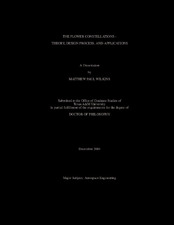| dc.description.abstract | In this research, constellations of satellites all having orbits compatible with rotating
reference frames are considered. That is to say, no matter how many satellites are considered
for the constellation, when viewed from an arbitrarily defined rotating reference frame
of interest, they all follow a single, identical relative trajectory. In this regard, one could
think of the relative trajectories as ?space trajectories on a rotating reference frame.?
In particular, this research concerns itself with reference frames constrained to rotate
with the planet under consideration (e.g. the Earth Centered Earth Fixed (ECEF) frame,
a frame rotating with the Earth). When the axis of symmetry of these constellations is
aligned with the spin axis of the planet, then the ground track as projected onto the planet
surface will be repeating.
Flower Constellations are identified by eight parameters. Five are integer parameters:
the number of petals (Np), the number of sidereal days to repeat the ground track (Nd), the
number of satellites (Ns), and two integers to govern the phasing (Fn and Fd). Three are
orbit parameters that are generally equal for all satellites: the argument of perigee (w), the
orbit inclination (i), and the perigee altitude (hp). Each of these parameters has a unique effect on the overall design of a Flower Constellation. Based upon specific choices of these parameters, some broad categories of constellation types are presented along with some unique cases. Often, a large number of satellites are used to completely visualize these constellations. While Flower Constellations lend themselves to micro- and nano-satellite constellations very easily, they are also readily scalable to any mission requirement. Also investigated are inverse design techniques where the governing equations are solved for the Flower Constellation parameters to achieve a desired final constellation or formation shape. Flower Constellations present beautiful and interesting dynamical features that allow us to explore a wide range of potential applications that include: telecommunications, Earth and deep space observation, global positioning systems, and new kinds of formation flying schemes among others. To demonstrate their potential, some specific Flower Constellations are described and discussed. Finally, the effect of perturbations such as the Earth?s oblateness are investigated and options for mitigating perturbations are discussed. | en |


